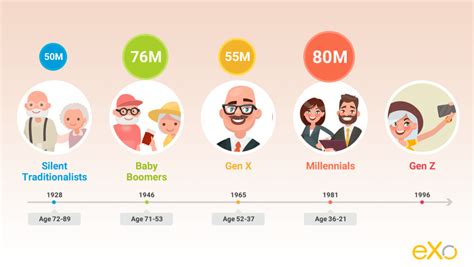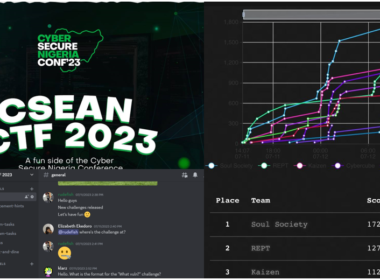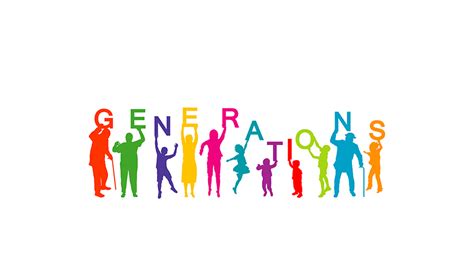There is no sugarcoating the truth that different generations interact with technology differently. For a sweet comparison, consider how it used to be the norm to knock on a neighbour’s door to borrow some sugar — and your grandparents still might do just this. These days, we can have an entire bag of sugar delivered to our doorsteps within a few clicks on a grocery delivery app.
Tech-savviness is not necessarily something that runs in the family. To some degree, it is something we are born into, depending on how tech-forward the world was when we entered it. This is a part of the reason younger generations are more comfortable interacting with technology because they know the world no other way. They are digital natives. It is also why older generations may be more hesitant about engaging in online activities because they must adapt to them. They are digital immigrants. Here we dig into these technology gaps across digital generations to unveil just how each group interacts with technology today, including cybersecurity dilemmas they might face and how to stay cyber safe, no matter one’s age.
An Overview of Digital Generations
What are digital generations? You can look at it from several viewpoints, but as a singular view, a digital generation can be considered as encompassing only people who were born into or raised in the digital era. This means with widespread access to modern-age technology such as smartphones, tablets, computers, and digital information like the internet. For this overview, we prefer the viewpoint that every living person today can be considered part of a digital generation because no matter how much we engage with technology we are living in a digital-first world.
Of course, the degree to which each person is comfortable and willing to embrace technology is also dependent on when they entered the world. Just look to the following generations and when they were born:

- Silent Traditionalists were born between 1925–1945
- Baby Boomers were born between 1945–1965
- Gen X was born between 1965–1980
- Millennials were born between 1980–1995
- Gen Z was born between 1995–2010
- Gen Alpha born in 2010 to the present day
Considering how far evolved technology was when each generation was born, we can categorize these generations into digital natives and digital immigrants, terms first coined by Marc Prensky in 2001. Digital immigrants were born or raised in an era before the world started turning toward a tech-first society. They do remember a world before the internet was on the rise, which means Gen X, Baby Boomers, and Silent Traditionalists, are all considered digital immigrants.
Incorporating technology into their daily lives is not so inherent for these digital generations. They have had to learn to adapt to the digital-first world and sometimes are sceptical of doing it, oftentimes considering old-school solutions before humouring new-wave conveniences. To go back to our sugar example, digital immigrants might first think to knock on a neighbour’s door for some sugar over ordering an entire bag online or even texting a neighbour for some.
Generally, digital immigrants are also slower to leverage the internet or connected devices and they are also sometimes less aware of how they work in the first place — and the threats associated with them. Digital natives know no world other than a digital-first one. They are typically more fluent in tech talk because they were born into or raised in the digital era, meaning when there was widespread access to the internet and devices like computers and smartphones readily available.
To digital natives, adapting to the evolution of technology is inherent, but that does not always mean they are aware of the threats associated with new internet and device advancements. So, what age groups are digital natives? Most regard digital natives as people born after the internet was developed in the early ’80s, which means Millennials, Gen Z, and Gen Alpha are all considered digital natives. With a concrete example, digital natives are people who would choose to have a bag of sugar delivered to their doorstep using an app over asking a neighbour for some sugar.
Technology Uses Statistics Across Digital Generations
Technology is ever-evolving and each digital generation adapts to these advancements at their own pace, whether it’s toddlers tuning into YouTube Kids on a tablet or seniors preferring email over texts to stay in touch with family. To paint a clearer picture of how each digital generation fits into our digital-first world today, we have rounded up the technology used in statistics across each generation. For due diligence, we have also put a cybersafety spin on the data to shed light on some of the risks these generations might face, including corrective measures to help protect their online activities. We shall respect our elders and address the oldest digital generation first.
Silent Traditionalists and Technology

Born between 1925–1945 — years of war and depression — Silent Traditionalists are considered the oldest living digital generation. The jukebox was perhaps the most used piece of technology when they entered the world. These days, data shows that Silent Traditionalists turn to technology mostly to stay in touch with families.
For perspective on how even the youngest of Silent Traditionalists interact with technology, according to an AARP study:
- 63 percent of Silent Traditionalists say going online increases communication with family members and 56 percent use a computer to connect with people.
- Still, Silent Traditionalists are not using social media to stay connected, as 40 percent avoid or do not use social media sites altogether.
- Instead, Silent Traditionalists prefer email most in terms of digital communications, with 60 percent indicating so. (Worth mentioning is that 72 percent of Silent Traditionalists prefer using a phone above all to stay in touch with others.)
Cybersafety Risks and Remedies for Silent Traditionalists
Considering Silent Traditionalists most often turn to computers and email for the sake of communication, there are a few common internet scams this digital generation should watch out for.
The risks: Tech support scams can occur on computers, especially in the form of malicious pop-ups that indicate you need to download software to correct a computer virus. It might be an attempt to download malware on a device. Another risk to Silent Traditionalists… phishing scams often show up right in our inboxes and are messages from an illegitimate source asking for your personal information perhaps in an attempt to commit identity theft.
The fix: Installing antivirus software on a device can instill confidence in a user that their computer is already protected from pop-ups that might be malicious. In addition, Silent Traditionalists should be aware of common signs of fraudulent emails — think misspellings, poor grammar, urgent demands with threats of financial consequences, and logos that do not quite look right — and not interact with the email if they see these red flags.
Baby Boomers and Technology

Born between 1945 and 1965, Baby Boomers entered the world at the tail-end of World War II and the upswing of the economy. This digital generation is most regarded for its work ethic and also being some of the first adopters of home computers. While often more open to adapting to technological advancements than Silent Traditionalists, Baby Boomers are now more cosied up to technology than ever in light of the Covid-19 pandemic and have no intention of rescinding their tech-savvy ways.
For some context to how Baby Boomers use technology today, according to one survey during the pandemic:
- Baby Boomers showed a 431 percent increase in using grocery curbside pickup, meaning using an app or online service to order groceries.
- Baby Boomers showed a 469 percent increase in the utilization of telehealth.
- 88 percent of Baby Boomers say they will continue to use these types of technologies to make their daily life easier.
CyberSafety Risks and Remedies for Baby Boomers
When we turn to technology out of convenience, we sometimes pay for this by giving up our online privacy. Knowing how to safeguard information on common apps and platforms we utilize almost every day can go a long way in offsetting this.
The risks: The personal information we save in grocery delivery or pickup apps, including names, email addresses, delivery addresses, phone numbers, and payment methods, can be compromised in the event of data breaches. In a similar vein, the medical and billing information we provide to our doctors online can also be at risk in the event hackers can intercept it during telehealth video appointments.
The fix: Instead of saving your personal information for later on grocery delivery or pickup app, opt to input your information manually for each transaction. Also, always use strong, unique passwords and opt for two-factor authentication (2FA) if it is an option in these applications. To protect your medical information, encourage your provider to only share this information with you by phone instead of via text or email and use a video-conferencing service that relies on encryption for telehealth appointments.
Gen X and Technology

Born between 1965 and 1980, Gen X is also known as the latchkey generation for being brought up with little adult supervision. While still considered digital immigrants, Gen X was born at the point when our world turned into a digital-first society. Growing up, Gen X preferred email and phone calls for communication and they also were the first generation to embrace the Walkman. To the same tune, Gen X was also known as the MTV generation. Nowadays, Gen X continues to lean on technology mostly for communication but they have expanded beyond home phones.
For perspective about Gen X’s place in our digital-first world:
- Gen X embraced social media the fastest of all digital immigrants, with 74 percent of Gen Xers on social media today.
- Facebook is Gen Xers’ preferred social media platform, with nine in 10 Gen X social media users on it and spending roughly seven hours a week on the platform.
- True to their MTV Generation nickname, Gen X still loves TV, with Gen Xers watching about 165 hours of TV per month, including on smart TVs.
Cybersafety Risks and Remedies for Gen X
Social media is wonderful to stay in touch with others, but it also can be a breeding ground for personal privacy complications, if you don’t know how to share responsibility. Likewise, TV is a great escape from our reality, but these devices also come with a few privacy risks to consider.
The risks: On social media, oversharing in your “about me” fields, such as including your date of birth or alma mater, and also documenting your every move makes it easy for others to piece together your identity — and possibly steal it. On a separate note, today’s standard TVs that are smart TVs with internet-connected, voice-enabled features can track what you are searching and watching.
The fix: When it comes to social media, less is more in terms of protecting your privacy. Know that you don’t need to fill out every detail about yourself in those “about me” fields. Moreover, set your profile to private to ensure you are approving anyone who follows your activity. Similar to social media privacy settings, check your smart TV settings and disable the data tracking to keep your data secured.
To be continued…










Excellent write up from someone destined to be great.
Thank you so much Ibanga…